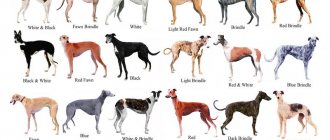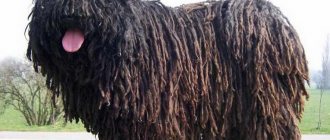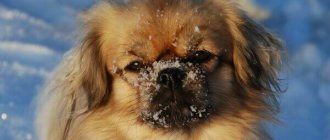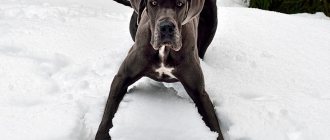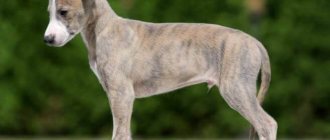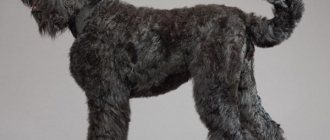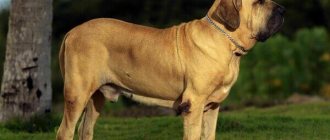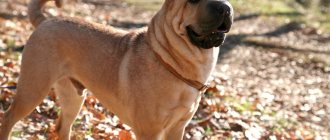The Welsh Terrier is a classic hunting dog. The Welsh Terrier is similar in appearance to the Airedale Terrier, but is an independent variety with its own characteristics and differences. Dog handlers and breeders around the world highly value the breed for its unique hunting abilities. However, before getting such a dog, you need to familiarize yourself with its main features.
Welsh Terrier - a small companion dog
History of the breed
The Welsh Terrier is considered one of the oldest known British breeds of hunting dogs. Cultivated in England. The name comes from the name of the region “Wales” or “Welsh” (colloquial). The Welsh Terrier dog was bred to hunt burrowing animals (badgers, foxes, and other small predators).
The first mention of the breed appeared more than 700 years ago. The approval of standards for the Welsh Terrier variety and the characteristics of the breed were approved only in the mid-19th century.
Health and life expectancy
Welsh Terriers live on average 12-15 years .
Common breed diseases:
- cataract,
- glaucoma,
- epilepsy,
- tendency to allergic reactions,
- hypofunction of the thyroid gland,
- Tartar formation and dental diseases.
Welsh dogs are at high risk of eye diseases. For prevention, the following must be taken:
- examine your eyes frequently;
- regularly clean the corners of the eyes from accumulated dust and dirt (carefully, using a cotton swab or disk);
- If there is irritation, redness or suppuration, you should immediately contact a veterinarian.
General information and breed standards
The Welsh Terrier dog breed standards were approved by the International Canine Organization in 2010 No. FCI 78.
Attention! The most stringent requirements are for color and behavior. Any deviations in the habits and reactions of the animal (excessive aggression, disobedience, etc.) lead to immediate disqualification.
Compliance with standards is required to participate in exhibitions
Comparison with the Airedale Terrier
Comparison of the Airedale Terrier and the Welsh Terrier is inevitable - the external similarity is obvious. However, there are some differences:
- Welsh dogs have a wider and longer muzzle;
- Airedales may have a curled tail, but this is inconvenient for a Welsh terrier;
- Airedales are an older variety of the line; Welsh Terriers are still considered the new standard.
For a long time, Welsh Terriers were simple working dogs. The owners did not consider it necessary to distinguish the dog from others.
Behavior and temperament
The contradiction in the terrier's character lies in the specific relationship to the owner. The dog’s attunement to humans is a plus. However, in situations where it is necessary to make an independent decision, the Welshman is helpless. Separation from the owner will also cause serious psychological trauma to the dog.
Positive sides:
- communication skills
- need for communication
- equilibrium,
- activity,
- learning ability,
- affection for the owner
- curiosity,
- for working dogs - anger towards the animal and endurance in a fight.
Negative features:
- pronounced dependence on the owner,
- lack of independence
- when developing character – the likelihood of nervous breakdowns,
- there is increased excitability,
- penchant for mischief,
- stubbornness.
In general, males are much calmer than females.
Color variations and appearance
The Welsh Terrier breed standards require the presence of recommendations on the accepted color options for the animal. Strict compliance is necessary if the dog participates in exhibitions, competitions, various shows and competitions.
Dimensions
In terms of size, Welsh Terriers are classified as medium-sized dogs. Adult pets grow up to 38 cm at the withers. The normal weight limit is up to 10 kg.
Attention! If the weight is more than the specified norm, the dog will not be allowed to compete. But the main thing is that the pet may develop health problems.
Wool
Animal fur is dense and hard, and can be a little unpleasant to the touch. The undercoat is thick, protects the pet well from cold and bad weather conditions, and is renewed during seasonal molting.
Color
The color of the Welsh Welsh has a name - shabby. The fur on the body is shiny black, the rest (paws, ears, muzzle) is red or brown. Spots are unacceptable, maximum - a lighter shade on the stomach.
The Welshman is often confused with other breed varieties, such as the Airedale.
Characteristics of the Welsh Terrier breed
Today there are two breed subtypes:
- worker;
- exhibition.
The difference lies in the general features of the figure and the characteristics of the coat: a working dog is stronger than a show dog and has a coarser coat.
Height at the withers of a male: 37-39 cm Height at the withers of a female: 35-37 cm Weight: 9-10 kg
Color: red-brown with black or gray-black saddle. Black color on the bottom of the paws is undesirable. The classic black saddle color appears at two years of age, before which they are black and tan.
General form:
- A short dog of proportional build, “square” format, not wide-bodied, with a narrow chest.
- The tail is strong and set high. In countries where there is no ban, the tail is docked so that its end is at the same level as the occipital protuberance.
- The head is rectangular.
- The eyes are dark brown, almond-shaped, set wide apart.
- The nose is black, powerful, square.
- Typical exterior defects of the breed are high stature (especially in males) and lack of teeth.
Care and maintenance
The optimal conditions for keeping Welsh Terriers are private territory. However, you will need to equip your own booth and a spacious enclosure. The dogs are active, springy, run and jump a lot.
Combing/grooming
The Welsh Terrier has a rough coat. Dogs participating in exhibitions go through several stages of grooming. Transitions in hair length should remain smooth and barely noticeable. Professional grooming is carried out as follows:
- removal of tangles and tangled lumps;
- hygienic treatment;
- bringing the claws into proper shape;
- bathing (use of special detergents for coarse hair is mandatory);
- drying wool with a hairdryer;
- treatment of the ears and area around the eyes.
Learning to cut hair begins in early childhood. Welsh Terrier puppies should understand that the procedure is safe and painless.
Bathing
Welsh dogs are bathed infrequently - about once a month. Allowed more often if the coat is dirty (for example, after a walk). It is necessary to use special shampoos and conditioners appropriate for the age of the pet.
Walk
Welsh Terriers require daily walking. Dogs are extremely active. To prevent your pet from causing trouble at home, it is necessary to provide him with sufficient exercise and play.
Ears
Dog ears are treated with scissors. It is better to use a small tool with rounded tips, carefully cutting out excess and regrown hairs.
Claws
Welsh dogs' claws are trimmed with a special nail clipper. The tool is directed at an angle of 35°. Do not remove claws or cut them too short - there is a high probability of damaging blood vessels.
Teeth
Dogs' teeth must be brushed regularly with a special brush. It is acceptable to use baking soda or specially formulated toothpaste. If you neglect treatment, plaque or stone may form, which will lead to inflammation and disease.
Eyes
Animals' eyes are treated regularly, more often during bathing and after walks. It is especially important to wipe the areas around the eyes in the summer when there is a lot of dust outside. Use a cotton swab dipped in a decoction of chamomile or tea.
Training and education
Welsh Terriers easily learn new things; the dogs are quite smart and quickly pick up tricks. Training is perceived as a game.
Attention! These pets are extremely playful. To achieve results and maintain them, you will need frequent repetition and a lot of patience.
Pets require a lot of attention and constant training
Physical exercise
Physical activity is necessary on a daily basis. The irrepressible energy of pets requires an outlet. If you do not provide constant activity on the street, the dog will begin to compensate for this at home - gnawing, barking, running, getting out of control.
Is it possible to keep in an apartment?
Welsh Terriers are small dogs. The best option is your own territory and a private house. But such pets can also be kept in an apartment. The main thing is to ensure frequent walks and sufficient physical activity.
Education and training
Welsh is famous for its trainability. One of the characteristics by which the breed was selected is the ability to establish contact with humans .
A working individual requires attentiveness and consistent education. If the owner wants successful work, then he needs to engage in baiting from a young age under the guidance of an experienced instructor.
Under no circumstances should physical methods of persuasion be used. This traumatizes the animal’s psyche and will not bring useful results.
Dimensions and weight
Dogs belong to the group of medium-sized pets. Standard dimensions of adult Welsh Terriers: height at the withers 33-38 cm, weight up to 11 kg. If the Welsh Terrier weighs more than necessary, it means that he is being overfed. Excess weight will lead to loss of proportional appearance and health problems.
Without sufficient physical activity, the pet will begin to look for other “outputs” for its own activity.
History of the origin of the species
The Welsh Terrier is a breed of English origin. The appearance of the species is explained differently everywhere. The ancestor of these dogs is the English Terrier. It had a black color with tan marks and was used in agriculture and hunting. The terrier helped pull out prey hidden in a hole.
Catching rodent pests was an outstanding ability, entertainment and one of the household duties of the ancestors of this breed.
The Welsh Terrier in its modern form has been cultivated since the 19th century. The characteristics of the breed were recorded in 1885. The first club of Welsh Terrier dog breeders was founded in 1886. At the turn of the 19th and 20th centuries, 100 representatives of the breed were presented at a dog show in Liverpool. Since then, the hunting breed has earned recognition in Foggy Albion. In the 1970s, the Welsh Terrier gained international recognition.
Nutritional Features
Welsh Terriers are not picky eaters. There are two feeding options - natural food or specialized food. The choice is made before the puppy arrives in the house, and then adhered to throughout the pet’s life. Natural products include:
- meat;
- cottage cheese (preferably mixed with kefir);
- porridge (rice, buckwheat);
- eggs (no more than twice a week);
- vegetables fruits.
Welsh Terriers should not be fed food with salt, spices, or sugar. Potatoes and flour are prohibited.
When choosing industrial feed, you need to give preference to premium brands.
How to choose a puppy
- When buying a Welsh Terrier puppy, pay attention to its parents , read the pedigree.
- The puppy should be well-fed and active , with healthy, thick and shiny hair.
- Don't forget to check his bite - it should be correct, with twelve incisors above and below.
- Be sure to study the exhibition standards and refer to them.
- head should be square in shape with a strong, flat forehead without a pronounced transition to the muzzle, the front part of the muzzle should be U-shaped.
- The limbs should be of medium length and parallel to each other.
In conclusion, it is worth saying that Welsh Terriers, like any other dogs, love to be cared for and given attention. Therefore, if a person is ready to give all of himself to this dog, then it will become his true friend and companion.
How much do Welsh Terrier puppies cost?
The price for a Welsh Terrier puppy ranges from 10,000 rubles to 35,000 rubles. Pet class puppies cost less. These are dogs that are not intended for breeding and exhibitions, and have signs of breed rejection. Show class puppies are promising individuals whose future is high achievements in the ring, as well as further production of high-quality offspring. Often in private advertisements you can find puppies or mature young animals, which are given free of charge, into good hands.
Nurseries
To purchase a high-quality Welsh Terrier puppy with a good pedigree, it is better to contact experienced breeders. Kennels that professionally breed dogs will help the future owner in choosing a pet. They will tell you about the conditions of detention and care.
- Nursery "Welsh" Moscow region https://welsh.ru/
- Nursery "Siverskii", Moscow https://www.siverskii.ru/siver.html
- Kennel “Iz Petergof” Leningrad region https://welshterrier.pet/
The Welsh Terrier dog breed is gaining more and more fans every year. A small dog that loves activity and movement is suitable as a companion and companion for an equally energetic person.
Price
In Russia, these proud burrow hunters are adored. In this country they even created a club for their fans. However, they are considered rare here. The price of a Welsh Terrier in Russia in 2019 ranges from 10 to 30 thousand rubles. It depends on the following parameters:
- Availability of pedigree.
- Availability of a veterinary passport.
- Degree of compliance with the breed standard.
- Having champion parents.
We recommend purchasing from the capital's nursery "From Wales".
Socialization
Early socialization is necessary for the Welsh Terrier, because stubbornness and independence are inherent in the character at the genetic level. A socialized dog obeys not instincts, but the demands of the owner.
Usually a puppy goes to a new home at the age of 2 months. The familiar environment surrounded by brothers and sisters changes to a new, unfamiliar space. Getting to know other family members and instilling basic rules of behavior is necessary to shape the pet’s character.
The Welsh Terrier treats other dogs living in the same territory with restraint. But he can perceive an adult cat as prey. But it can also become a good friend if the animals entered the house at the same time at an early age.
Welsh Terriers love children and will never hurt them. They will keep company in joint games and mischief.
Advantages and disadvantages
Assessing the breed qualities of Welsh Terriers, we can affirmatively state that they are energetic, inquisitive and playful creatures. In addition, they are quite loyal to their owner. Possessing a fair amount of courage, they are able to stand up for their owner, family and property entrusted to them for protection.
Males are much more simple-minded than females and are noticeably more peaceful towards other breeds. But females and males are connected by a common dislike for cats and rodents, as well as aggression directed towards dogs of the same sex.
If mistakes are made in raising a Welshman, and the pet is given some slack, the dog will grow up spoiled and capricious. The Welsh Terrier is a sociable dog that needs constant communication. But the quality of this communication may vary. But in any case, forced loneliness contributes to the manifestation of destructive behavior.
Names and nicknames
The nickname given in the kennel (and it is strictly not recommended to purchase a Welsh Terrier dog outside the walls of the breeding plant) can be assigned to the dog forever. Even if the dog’s pet name was chosen before its purchase. After all, the breeder not only delivers the baby, but also observes the puppies, noting the characteristics of each individual.
Despite the fact that the entire litter is named with the same letter in accordance with the nursery’s stud book, the breeder records in the nickname the pronounced character traits of each puppy. Therefore, listen to the sound of the little Welshman’s name, and if, due to the move, the baby has reformatted his character, which often happens, you can safely give him a pet name.
Possible diseases and methods of treating them
The Welsh Terrier is a hardy and very healthy working dog with excellent immune protection. But if she is not cared for properly, she gets sick and dies prematurely. For example, it has been proven that regular overeating of a dog leads to its obesity. And this, in turn, provokes dysfunction of the heart, liver, kidneys and other vital organs.
The best prevention of obesity in a dog is balanced and rationed feeding! Also, some Welsh Terriers, especially older ones, are prone to epilepsy. It is difficult to completely cure this disease. If you notice that your four-legged pet is having an epileptic seizure, you need to invite a doctor. You cannot prescribe him any medications on your own.
Also, take the advice of a specialist to purchase parasite medications for your pet: fleas and worms. And lastly, don’t forget about vaccines! They will protect your Welsh from dangerous viruses and infections.
Character
The Welsh Terrier is a cheerful, slightly eccentric, energetic companion. Very smart and obedient, easily controlled in everyday life. Perky and fearless, but by no means aggressive. He tries to avoid conflicts, but if necessary, he will be able to stand up for himself.
Welsh Terriers are kindly cunning, stubborn and resourceful. They will try in every possible and impossible way to achieve what they want.
Living together with other animals is difficult to predict. They rarely get along with dogs of other breeds. They do not get along well with cats, and small animals and birds are considered potential prey by Welshies.
The Welsh Terrier is sincerely devoted to its owner and adores all family members. Treats strangers with caution or indifference. He has remarkable courage and is capable of defending the owner and property.
Mating
The mating of a toy is a complex event that requires seriousness from the owner of the baby. Mating takes place if the male or female has reached the age of 15 months. A tiny dot weighing up to 1.8 kg cannot be bred, as it is difficult for her to bear litter.
The bitch is bred for her third heat. It's better if she is taken to the boy's territory. The correct choice of a male will qualitatively improve the further breed of English Toy Terrier dogs.
Please note: childbirth is more difficult for small dogs than for large dogs. It is advisable that the process of pregnancy and childbirth be observed by a veterinarian.
Description of the Welsh Terrier breed
These dogs are small in size, the coat is quite hard, which helps protect the dog’s skin from bad weather and various damages.
Now, you will learn a more detailed description of the Welsh Terrier breed:They are very deceiving in appearance. They look elegant and graceful. At the same time, Welsh Terriers are very dexterous, nimble and active dogs.
- The body is elongated and thin.
- The head is very square-shaped, slightly elongated, the jaw gives the dog a courageous, heroic appearance.
- The eyes are deep, oval, even a little like almonds, and the gaze is interested, observing and aiming.
- The ears usually droop and are triangular in shape.
- The nose is black, rounded.
- The neck is narrow, widening and increasing towards the shoulders.
- The tail is set quite high, long, and sometimes docked.
Next we will tell you the characteristics of the Welsh Terrier.
